小学英语形容词与副词的比较级与最高级讲解学习
形容词和副词的比较级与最高级用法总结与解析
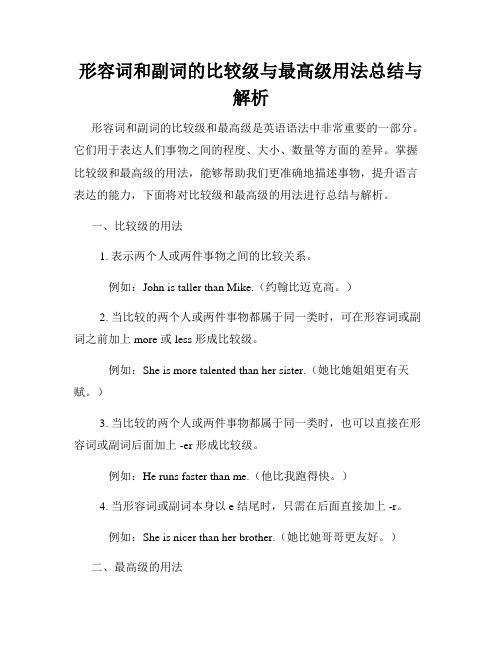
形容词和副词的比较级与最高级用法总结与解析形容词和副词的比较级和最高级是英语语法中非常重要的一部分。
它们用于表达人们事物之间的程度、大小、数量等方面的差异。
掌握比较级和最高级的用法,能够帮助我们更准确地描述事物,提升语言表达的能力,下面将对比较级和最高级的用法进行总结与解析。
一、比较级的用法1. 表示两个人或两件事物之间的比较关系。
例如:John is taller than Mike.(约翰比迈克高。
)2. 当比较的两个人或两件事物都属于同一类时,可在形容词或副词之前加上 more 或 less 形成比较级。
例如:She is more talented than her sister.(她比她姐姐更有天赋。
)3. 当比较的两个人或两件事物都属于同一类时,也可以直接在形容词或副词后面加上 -er 形成比较级。
例如:He runs faster than me.(他比我跑得快。
)4. 当形容词或副词本身以 e 结尾时,只需在后面直接加上 -r。
例如:She is nicer than her brother.(她比她哥哥更友好。
)二、最高级的用法1. 表示三个或三个以上人或事物之间的比较关系。
例如:He is the tallest among all the students.(他是全班同学中最高的。
)2. 当比较的三个或三个以上人或事物都属于同一类时,可在形容词或副词之前加上 most 或 least 形成最高级。
例如:It's the most beautiful place I have ever seen.(那是我见过的最美的地方。
)3. 当比较的三个或三个以上人或事物都属于同一类时,也可以直接在形容词或副词后面加上 -est 形成最高级。
例如:This is the fastest car in the world.(这是全世界最快的车。
)4. 如果形容词或副词本身以辅音字母 + y 结尾,则将 y 变为 i,再加上 -est。
学习重要知识归纳形容词与副词的比较级与最高级
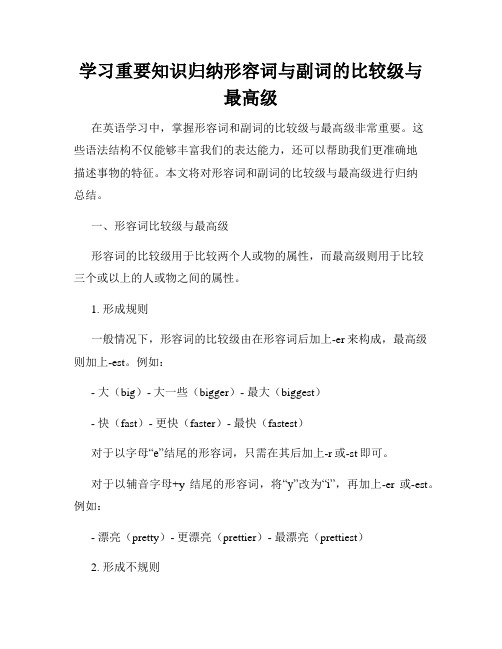
学习重要知识归纳形容词与副词的比较级与最高级在英语学习中,掌握形容词和副词的比较级与最高级非常重要。
这些语法结构不仅能够丰富我们的表达能力,还可以帮助我们更准确地描述事物的特征。
本文将对形容词和副词的比较级与最高级进行归纳总结。
一、形容词比较级与最高级形容词的比较级用于比较两个人或物的属性,而最高级则用于比较三个或以上的人或物之间的属性。
1. 形成规则一般情况下,形容词的比较级由在形容词后加上-er来构成,最高级则加上-est。
例如:- 大(big)- 大一些(bigger)- 最大(biggest)- 快(fast)- 更快(faster)- 最快(fastest)对于以字母“e”结尾的形容词,只需在其后加上-r或-st即可。
对于以辅音字母+y结尾的形容词,将“y”改为“i”,再加上-er或-est。
例如:- 漂亮(pretty)- 更漂亮(prettier)- 最漂亮(prettiest)2. 形成不规则除了规则构成的比较级和最高级外,还存在一些不规则形式。
例如:- 好(good)- 更好(better)- 最好(best)- 少(few)- 较少(fewer)- 最少(fewest)- 多(many)- 更多(more)- 最多(most)3. 比较级和最高级的用法比较级用于比较两个人或物的相对程度,最高级则用于三个或以上人或物之间的比较。
例如:- 我的车比他的车快。
My car is faster than his.- 这座山是我们所爬过的最高的山。
This mountain is the highest we have climbed.需要注意的是,当形容词比较级前出现“the”时,表示“……之一”,相当于最高级。
例如:- 他是我们班最高的学生之一。
He is one of the tallest students in our class.二、副词比较级与最高级副词的比较级和最高级的构成与形容词类似。
形容词、副词比较级和最高级讲解与练习
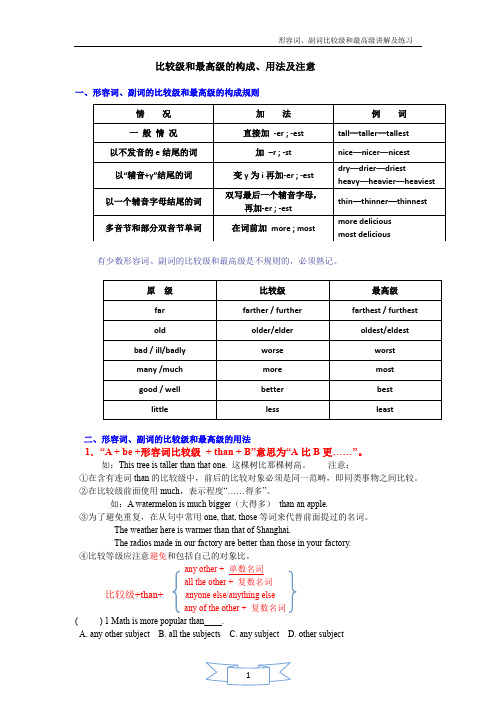
比较级和最高级的构成、用法及注意一、形容词、副词的比较级和最高级的构成规则有少数形容词、副词的比较级和最高级是不规则的,必须熟记。
二、形容词、副词的比较级和最高级的用法1.“A + be +形容词比较级+ than + B”意思为“A比B更……”。
如:This tree is taller than that one. 这棵树比那棵树高。
注意:①在含有连词than的比较级中,前后的比较对象必须是同一范畴,即同类事物之间比较。
②在比较级前面使用much,表示程度“……得多”。
如:A watermelon is much bigger(大得多)than an apple.③为了避免重复,在从句中常用one, that, those等词来代替前面提过的名词。
The weather here is warmer than that of Shanghai.The radios made in our factory are better than those in your factory.④比较等级应注意避免和包括自己的对象比。
any other + 单数名词all the other + 复数名词比较级+than+anyone else/anything elseany of the other + 复数名词( ) 1 Math is more popular than____.A. any other subjectB. all the subjectsC. any subjectD. other subject( ) 2 China is larger than ____ in Asia .A. any countryB. other countriesC. the other countryD. any other country ( ) 3 Tom is stronger than ___ in his class.A. any other boy sB. any boysC. any other boyD. other boy⑤比较级前一般不用冠词,但若表示“两者中较……时”。
小学六年重要知识点解析形容词与副词的比较级与最高级

小学六年重要知识点解析形容词与副词的比较级与最高级形容词与副词是我们日常生活中经常使用的词类。
它们用于描述事物的特征、状态、程度等,帮助我们更准确地表达思想和感受。
在小学六年级中,学生需要掌握形容词与副词的比较级与最高级,以便更好地运用它们。
一、形容词的比较级与最高级1. 形容词的比较级形容词的比较级用于比较两个人或事物的性质或特征,表示“更……”的意思。
形容词的比较级的构成方式有以下几种情况:1) 一般在形容词词尾加-er。
例如:- 好→更好:good → better- 高→更高:tall → taller2) 以字母“e”结尾的形容词,在词尾加-r。
例如:- 大→更大:large → larger- 强→更强:strong → stronger3) 以辅音字母+y结尾的形容词,把y变为i,再加-er。
例如:- 快→更快:quick → quicker- 早→更早:early → earlier4) 辅音字母结尾的重读闭音节词,需双写末尾的辅音字母,再加-er。
例如:- 大→更大:big → bigger- 短→更短:short → shorter5) 部分词以“er”结尾,直接加-er。
例如:- 简单→更简单:simple → simpler- 漂亮→更漂亮:beautiful → more beautiful2. 形容词的最高级形容词的最高级用于比较三个或三个以上的人或事物的性质或特征,表示“最……”的意思。
形容词的最高级的构成方式有以下几种情况:1) 一般在形容词前加the + 形容词的最高级。
例如:- 好→最好:good → the best- 高→最高:tall → the tallest2) 以字母“e”结尾的形容词,在词前加the。
例如:- 大→最大:large → the largest- 强→最强:strong → the strongest3) 辅音字母结尾的重读闭音节词,在词前加the。
形容词和副词的比较级与最高级学习形容词和副词的比较级和最高级形式
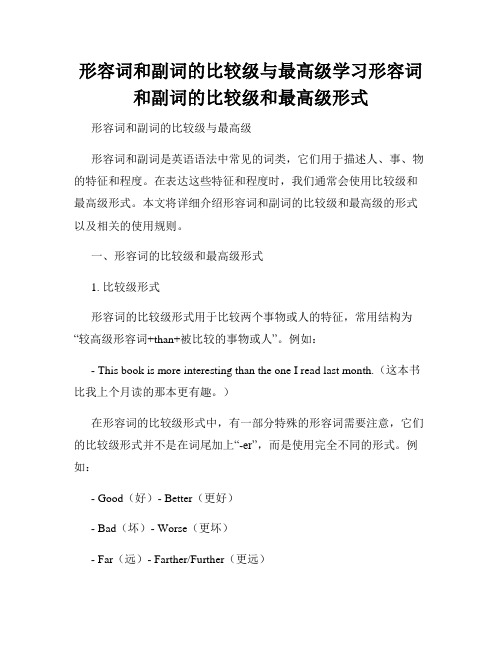
形容词和副词的比较级与最高级学习形容词和副词的比较级和最高级形式形容词和副词的比较级与最高级形容词和副词是英语语法中常见的词类,它们用于描述人、事、物的特征和程度。
在表达这些特征和程度时,我们通常会使用比较级和最高级形式。
本文将详细介绍形容词和副词的比较级和最高级的形式以及相关的使用规则。
一、形容词的比较级和最高级形式1. 比较级形式形容词的比较级形式用于比较两个事物或人的特征,常用结构为“较高级形容词+than+被比较的事物或人”。
例如:- This book is more interesting than the one I read last month.(这本书比我上个月读的那本更有趣。
)在形容词的比较级形式中,有一部分特殊的形容词需要注意,它们的比较级形式并不是在词尾加上“-er”,而是使用完全不同的形式。
例如:- Good(好)- Better(更好)- Bad(坏)- Worse(更坏)- Far(远)- Farther/Further(更远)2. 最高级形式形容词的最高级形式用于表示三个或三个以上事物或人之间的比较,常用结构为“the+最高级形容词+of/in/among+被比较的事物或人”。
例如:- She is the tallest girl in our class.(她是我们班最高的女孩。
)形容词的最高级形式中,同样存在一些特殊的形容词,其最高级形式也有所不同。
例如:- Good - Best- Bad - Worst- Far - Farthest/Furthest二、副词的比较级和最高级形式1. 比较级形式副词的比较级形式与形容词的比较级相似,通常在词尾加上“-er”。
例如:- He runs faster than his brother.(他跑得比他哥哥快。
)需要注意的是,有一些副词的比较级形式与形容词相同,但意思不同。
例如:- Hard(硬)- harder(更努力)- Fast(快)- faster(更快)2. 最高级形式副词的最高级形式与形容词的最高级形式类似,在词尾加上“-est”。
形容词与副词的比较级与最高级全面解析形容词与副词的比较级与最高级的构成与用法

形容词与副词的比较级与最高级全面解析形容词与副词的比较级与最高级的构成与用法形容词与副词的比较级与最高级全面解析形容词和副词是我们日常表达中经常使用的词性,通过比较级和最高级的构成与用法,我们可以更准确地描述事物的特征和行为的程度。
接下来,本文将对形容词和副词的比较级与最高级进行全面解析,帮助读者更好地理解和运用这两种语法结构。
一、形容词的比较级与最高级构成1. 比较级的构成形容词的比较级可以由两种形式构成:添加后缀“-er”或使用more + 形容词来表示。
例如:- old(老的)-- older(更老的)- beautiful(美丽的)-- more beautiful(更美丽的)需要注意的是,当形容词以“e”结尾时,只需要在后面添加“r”,而不需要双写“e”。
例如:- large(大的)-- larger(更大的)2. 最高级的构成形容词的最高级可以通过两种形式来构成:添加后缀“-est”或使用most + 形容词来表示。
例如:- old(老的)-- oldest(最老的)- beautiful(美丽的)-- most beautiful(最美丽的)和比较级相似,当形容词以“e”结尾时,只需要在后面添加“st”,而不需要双写“e”。
例如:- large(大的)-- largest(最大的)二、比较级与最高级的用法1. 比较级的用法比较级主要用来对两个或多个事物进行比较,表示其中一方的程度高于另一方。
例如:- This book is more interesting than that one.(这本书比那本书更有趣。
)- He runs faster than his brother.(他跑得比他兄弟快。
)需要注意的是,在比较级中,我们常使用than来引导之后的比较对象。
2. 最高级的用法最高级主要用来表示在一组事物中,某个事物的程度达到最高。
例如:- This is the oldest tree in the forest.(这是森林中最古老的树。
形容词和副词的比较级和最高级讲解+练习

形容词和副词的比较级和最高级形容词:修饰名词, 说明事物或人的性质或特征,可翻译为“....的”副词:用以修饰动词、形容词或其他副词的词叫做副词,可翻译为“....地”考点1:形容词副词的基本句型(1) 原级的用法考点2:形容词副词的比较级最高级形容词等级口诀比较级要变化,一般词尾加-er,词尾若有哑音就可以直接加r一辅重读闭音节,辅音字母要双写。
辅音字母后有y,把y改成i 最高级加-est,莫忘前面加the。
形容词若是多音节,记得前面加more/mostThe weather in Guangzhou is hotter than that in Beijing.1.The weather in Guangdong is hotter than ________ in Beijing.2.The buildings of Beijing are higher than ________ of Zhongshan.练习:1.Our classroom is____ larger than theirs.A. moreB. quiteC. veryD. much2. It was very hot yesterday, but it is___ today.A. even hotterB. more hotterC. much more hotD. much hot3.-Now the air in our city is ________ than it used to be. -I agree. I think something must be done to stop it.A.very goodB.rather badC. much betterD.even worse4.Which do you like ___, tea or coffee?A. wellB. betterC. bestD. most6.Of the two cups, he bought____.A. the smallerB. the smallestC. smallD. smaller7.The ______ kids learn to depend on themselves, the ______ it is for their futureA.early; goodB.early; betterC.earlier;betterD.earlier;good8.___ I look at the picture, ____ I like it.A. The best; the moreB. The more; the lessC. The more; lessD. More; the more9. By and by, ____ students in our class came to like English.A. more and moreB. much and muchC. many and manyD. less and least10. At last he began to cry ___.A. hard and hardB. more hard and more hardC. harder and harderD. less hard and less harder11._______ bag looks much better than _______A.Your; mineB.Your; myC.Yours; mineD.Yours; my12. ---Both of the skirts are in style this year. ---But I think this one is _____.A. popularB. much popularC. more popularD. the most popular13.-______ plastic bags we use, ______ it will be to the environment. -I agree ______ you.A.The less; the better; withB.The fewer; the better; withC.The less; the worst; toD.The fewer; the worse; to14.-Do you think children should get a child ticket according to their height or their age?-______. After all, children today are much taller than children in the past.A.Yes, I doB.No, I don'tC.Their height, of courseD.Their age, of course考点3:最高级的用法(三者或以上的比较或选择)注意:(1) 形容词最高级前有物主代词修饰时不用the: He is my best friend.(2) 最高级与比较级的转换:Shanghai is the largest city in China.=Shanghai is larger than any other city in China. (上海属于中国)区别:Shanghai is larger than any city in Japan. (上海不属于日本)1.___ is more beautiful than roses.A. No other flowerB. No another flowerC. Not other flowerD. Not all flowers2.-Do you enjoy Han Lei's songs?-Yes .He is the winner of I'm Singer II. I can't think of anyone with a _____ voice.A. betterB. bestC. moreD. most作业:1.The Great Pyramid is about 137 metres high today, but it was once ________.A. higherB. highestC. high tooD. more high2.Who jumped____of all?A. farB. fartherC. farthestD. the most far3.Li Lei is___ student in our class.A. tallB. tallerC. tallestD. the tallest4.English is one of____ spoken in the world.A.the important languagesB.the most important languagesC.most important languageD.the most important language5.Beijing is one of____ in China.A. the largest cityB. the large citiesC. the larger citiesD. the largest cities6. We are happy to see our city is developing____these years than before.A. quicklyB. more quicklyC. very quicklyD. the most quickly7. -It's smoggy these days. That's terrible!-Yes, I hope to plant trees.____trees,____air pollution.A.The more; the fewerB. The less; the moreC. The less; the fewerD. The more; the less8. The safety of food has become one of the____problems in our daily life.A. more expensiveB. more importantC. most expensiveD. most important9. -Do you enjoy Han Lei's songs? -Yes .He is the winner of I'm Singer II. I can't think of anyone with a____voice.A. betterB. bestC. moreD. most10. There will be____jobs for people because some robots will do the same jobs as people.A. manyB. moreC. fewerD. less11.We must eat ________ fruit and vegetables to keep healthy every day.A.lessB.moreC.littleD.few真题练习:1. Peter is 15 year old. He is ___ than his father. (2016北京)A. tallB. tallerC. tallestD. the tallest2. -Your son used to be a homebody but he now likes outdoor activities. How did youdo that?-I tried many ways over and over again. _______ ,I made it. (2016东营)A. NextB. ThenC. FinallyD. Suddenly3. Shanghai Disney Park will be opened on June 16. But the tickets for the first dayhave ______ sold out.A. everB. justC. neverD. already4. -Sarah is chosen as the guide for the Fashion Show.-Great! No one speaks English _______ her. (2016咸宁)A. as beautiful asB. as badly asC. worse thanD. better than5. -Why didn't you cry for help when you were robbed (被抢劫)? (2016东营)-If I opened my mouth, they might find my four gold teeth. That would be ______!A. badB. much worseC. worstD. the worst6. -I think it's necessary to learn how to work in groups. -I quite agree. Sometimes it's even ________ than grades.A. less importantB. more importantC. the least importantD. the most important7. -His handwriting is very careful.-Yeah. With the help of him, his sister writes as______ as him. (2016铜仁)A. careB. carefulC. more carefullyD. carefully8. I have been to quite a few restaurants, but I can. say this one is . (2016河南)A. goodB. betterC. the betterD. the best9. -Do you know Shanghai is one of ______ in the world?-Yes, it's bigger than ______ city in China. (2016龙东)A.the biggest city; anyB. the biggest cities; anyC. the biggest cities; any otherD. the biggest city; any other10. I hope my school life of senior high will be ________ than that of junior high. (2016长春)A. more excitingB. very excitingC. as exciting asD. the most exciting11. In order to pass the exam, You need to work much ________now.(2016济宁)A. hardB. harderC. hardestD. hardly12. He won in the story competition and his parents were very . (2016江西)A. smartB. proudC. sorryD. upset13. I didn't do very well in this exam. Unluckily, he did it . (2016江西)A. worseB. badlyC. betterD. worst14. -Are you a fan of the science TV show Super Brain?-Yes, I'm always _____ by these people's great brainpower. (2016连云港)A. tiredB. amazedC. boredD. satisfied15. -Home is place wherever you go.-East or west, home is the best. (2016宜昌)A. warmB. warmerC. warmestD. the warmest16. My father caught a big fish this morning, but I caught a ______ one. I feel great!(2016绵阳)A. smallerB. biggestC. biggerD. big17. -Did you get Wechat red(微信红包)during the Spring Festival? (2016宜昌)-Yes. It's the most popular way of sending traditional holiday presents now.A. especiallyB. widelyC. actuallyD. hardly18. It was late. She opened the door ________ because she didn't want to wake up hergrandma. (2016重庆)A. angrilyB. quietlyC. loudlyD. heavily19. Last night the big fire in Sunshine Shopping Mall was started by the childrenplaying with matches. , no onewas hurt. (2016南京)A. LuckilyB. SuddenlyC. EasilyD. Sadly20. My sister is still very with me because I broke her new pencil box yesterday. (2016南京)A. popularB. satisfiedC. honestD. angry21. The talent show is ______ the game show. I like both. (2016青岛)A. as boring asB. not so bored asC. as interesting asD. not so interested as22. -Lily has two sisters, doesn't she? (2016咸宁)-Yes. She's taller and older than her two sisters, but she's not _____ one of the three.A. the tallestB. youngestC. shortestD. the cleverest23. -Many boy students think science is _______ English. -I agree. I'm weak in English. (2016西宁)A. much difficult thanB. so difficult asC. less difficult thanD. more difficult than24. The soup tastes ________ because it's too salty. I put salt into it too _______ in ahurry. (2016西宁)A. terribly; carefullyB. terrible; carefullyC. terrible; carelesslyD. terribly; carelessly25. This temple is one of ________buildings in the town. We must take action toprotect it. (2016上海)A. oldB. olderC. oldestD. the oldest26. The manager sounded________ on the phone. He offered to show us around thecompany. (2016上海)A. softlyB. friendlyC. gentlyD. seriously27. - Playing video games is a waste of time . -I agree . There are meaningful things to do .A. the mostB. the leastC. moreD. less28. A journey by train is than by plane. (2016天津)A. more relaxingB. relaxingC. most relaxingD. the most relaxing29. Tom fell off his bike, and his hand was hurt . (2016天津)A. quietlyB. carefullyC. slowlyD. badly30. -I can't stand swimming in cold rivers in winter. (2016咸宁)-But it's ______ for your health. You know I often swim in rivers in different seasons.A.helpfulB. harmfulC. painfulD. careful。
比较级与最高级的构成与用法详解形容词与副词的比较级与最高级形式
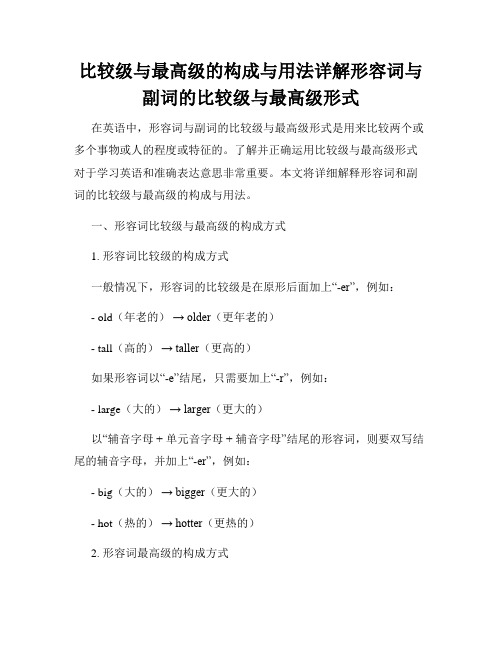
比较级与最高级的构成与用法详解形容词与副词的比较级与最高级形式在英语中,形容词与副词的比较级与最高级形式是用来比较两个或多个事物或人的程度或特征的。
了解并正确运用比较级与最高级形式对于学习英语和准确表达意思非常重要。
本文将详细解释形容词和副词的比较级与最高级的构成与用法。
一、形容词比较级与最高级的构成方式1. 形容词比较级的构成方式一般情况下,形容词的比较级是在原形后面加上“-er”,例如:- old(年老的)→ older(更年老的)- tall(高的)→ taller(更高的)如果形容词以“-e”结尾,只需要加上“-r”,例如:- large(大的)→ larger(更大的)以“辅音字母 + 单元音字母 + 辅音字母”结尾的形容词,则要双写结尾的辅音字母,并加上“-er”,例如:- big(大的)→ bigger(更大的)- hot(热的)→ hotter(更热的)2. 形容词最高级的构成方式形容词的最高级通常在原形后面加上“-est”,例如:- old(年老的)→ oldest(最年老的)- tall(高的)→ tallest(最高的)如果形容词以“-e”结尾,只需要加上“-st”,例如:- large(大的)→ largest(最大的)以“辅音字母 + 单元音字母 + 辅音字母”结尾的形容词,则要双写结尾的辅音字母,并加上“-est”,例如:- big(大的)→ biggest(最大的)- hot(热的)→ hottest(最热的)二、副词比较级与最高级的构成方式1. 副词比较级的构成方式大部分副词的比较级是在原形后面加上“-er”,例如:- fast(快速地)→ faster(更快地)- slowly(慢慢地)→ more slowly(更慢地)以“-ly”结尾的副词,直接在原形后面加上“-er”,例如:- quickly(快速地)→ quicker(更快地)2. 副词最高级的构成方式大部分副词的最高级是在原形后面加上“-est”,例如:- fast(快速地)→ fastest(最快地)- slowly(慢慢地)→ most slowly(最慢地)以“-ly”结尾的副词,直接在原形后面加上“-est”,例如:- quickly(快速地)→ quickest(最快地)三、形容词与副词比较级与最高级的用法1. 形容词与副词比较级的用法比较级常用于比较两个事物或人的程度,例如:- This book is more interesting than the last one.(这本书比上一本书更有趣。
- 1、下载文档前请自行甄别文档内容的完整性,平台不提供额外的编辑、内容补充、找答案等附加服务。
- 2、"仅部分预览"的文档,不可在线预览部分如存在完整性等问题,可反馈申请退款(可完整预览的文档不适用该条件!)。
- 3、如文档侵犯您的权益,请联系客服反馈,我们会尽快为您处理(人工客服工作时间:9:00-18:30)。
A. we B. us C. our D. ours
( ) 3 Please ask____ not to skate on the thin ice.
A. they B. them C. their D. theirs
小学英语形容词与副词的比较级与最高级
XXXX教育学科教师辅导讲义
讲义编号
学员编号:年 级:小六课时数:
学员姓名:辅导科目: 英 语学科教师:
学科组长签名及日期
学员家长签名及日期
课 题
形容词与副词的比较级与最高级
授课时间:
备课时间:
教学目标
掌握代词、特殊疑问句、形容词与副词的比较级与最高级的用法
重点、难点
( ) 3 ___ a heavy rain last night.
A. There had B. We had C. It was D. There is
( ) 4 ___ is 200 kilometres from here to the natural park. We have to go there by car.
A. There B. It C. This D. The place
( ) 1 The bird built___ nest in the tree.
A. it's B. her's C. hers D. its
( ) 2 Have you seen___pen, a black one?
A. these B. my C. you D. hers
A. you B. your C. yours D. her
( ) 4 You have a good room, I should say. But it's not as big as___.
形容词与副词的比较级与最高级
考点及考试要求
形容词与副词的比较级与最高级
教学内容
Step One:check homework
StepTwo:代词、特殊疑问句和代词的练习
( ) 1 Though it rained heavily, ____ were still playing on the playground.
A. one B. he C. she D. it
()1 ___ was late summer and the weather was very hot.
A. That B. It C. This D. It's
( ) 2 What time is ____ now?
A it B. all C. this D: that
A. she B. he C. one D. it
( ) 4 Only____know it.
A. I and he B. he and you C. he and I D. I and you
( ) 1 I saw___ playing in the street at that time.
A. them B. they C. their D. eirs
A. you, he and I B. you, him and me C. I, you and he D. me, you and him
( ) 1 Who's that at the door? ____ is the postman.
A. She B. This C. It D. He
( ) 2 -Who's that in the picture?
A. their; our B. their; ours C. theirs; ours D. theirs; our
( ) 2 They aren't our books. Are they____?
A. your B. his C. her D. their
( ) 3 Our room is bigger than ___.
( ) 4 The pen is hers. Pass it to____, please.
A. her B. she C. hers D. herself
( ) 5 Let me go and give the coat to____.
A. he B. his C. himself D. him
( ) 6 They asked___ to do the work.
A. her B. a C. the D. that
( ) 3 He apologized to me for hitting me___ face.
A. on the B. at the C. in the D. in my
( ) T Our room is big, but____ is bigger than____.
A. It's me B. That's I C. This is a boy D. It's I
( ) 3 -Look, who is coming?
-___ must be our English teacher.
A. She B. He C. It D. This
( ) 4 Someone is knocking at the door, but who can____ be?
3 Sorry I have forgot ____ telephone number.
A. yours B. him C. you D. his
( ) I The bear was shot in___ head. ? A. the B. its C. a D. this
( ) 2 The old man took the girl by ____ hand and they went down the street.
A. they B. them C. their D. themselves
( ) 2 Tom and ____ will go to see our teacher, for ___ is ill.
A. I; she. B. me; she C. I; her D. me; her
( ) 3 Is___a boy or girl?
